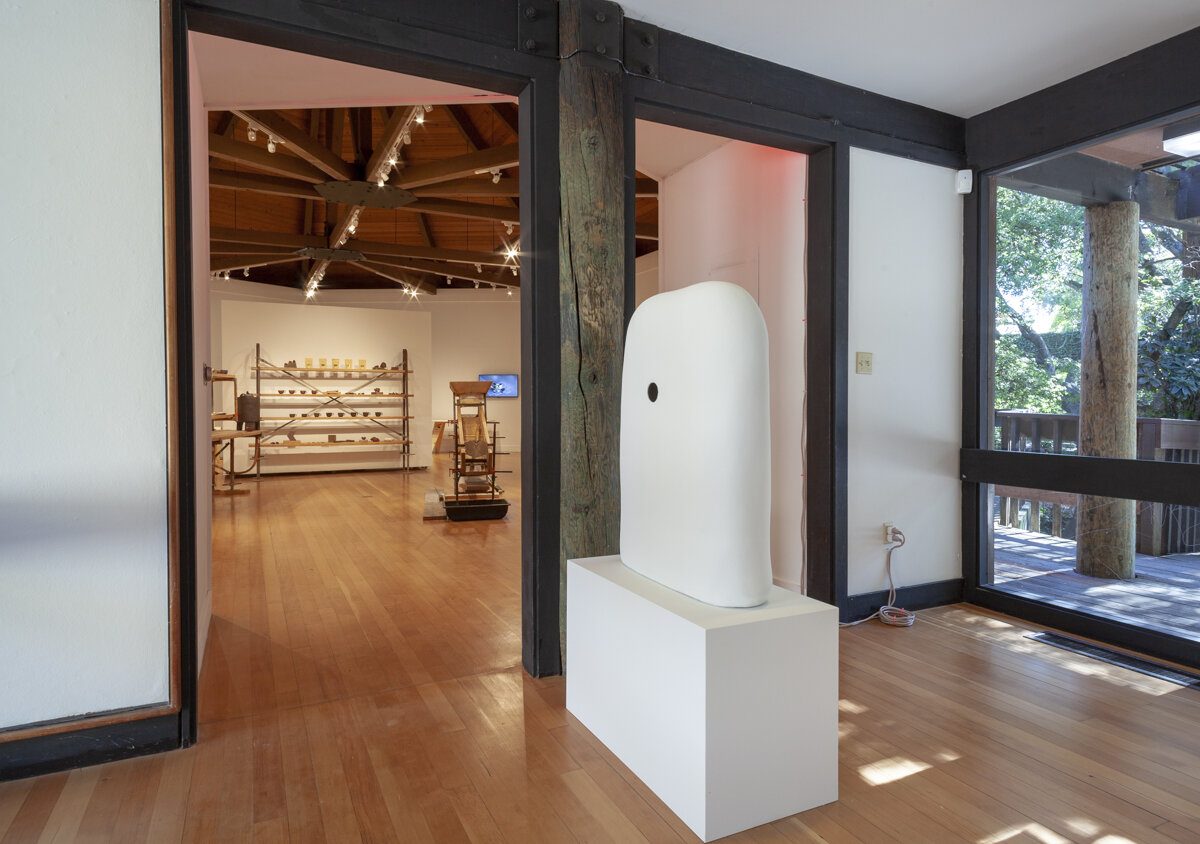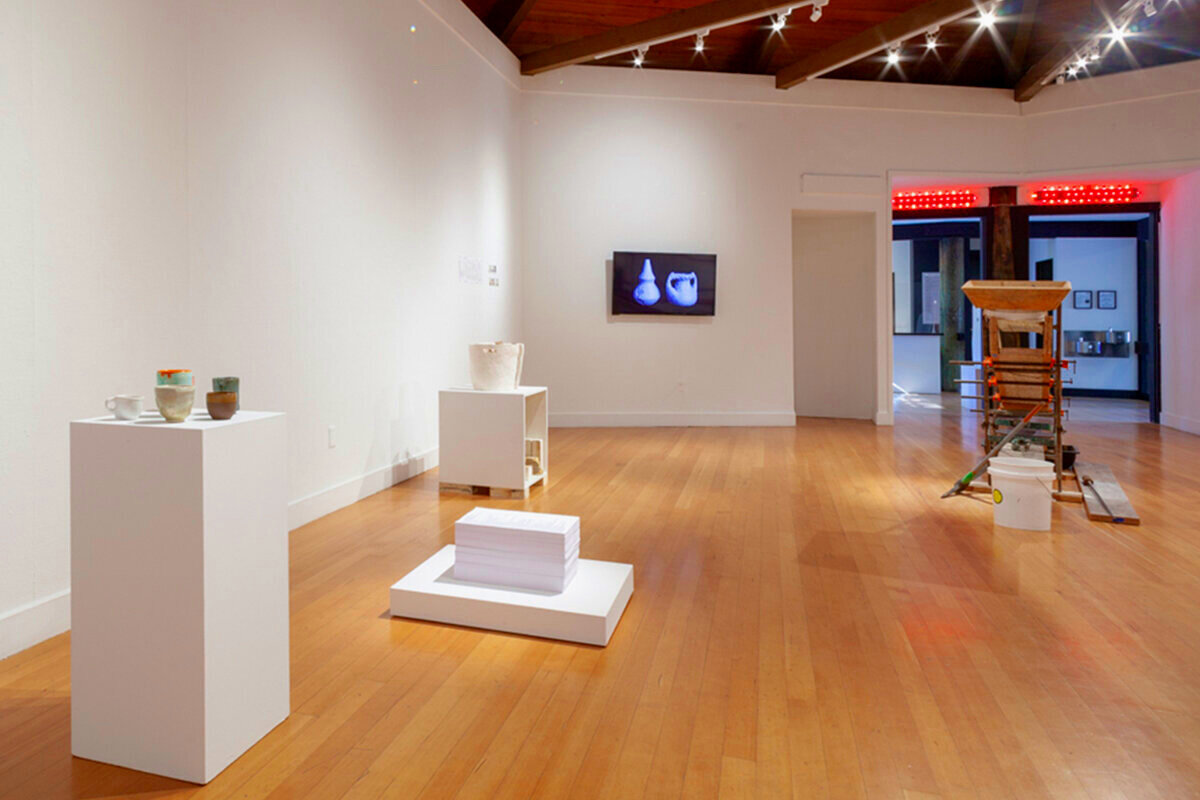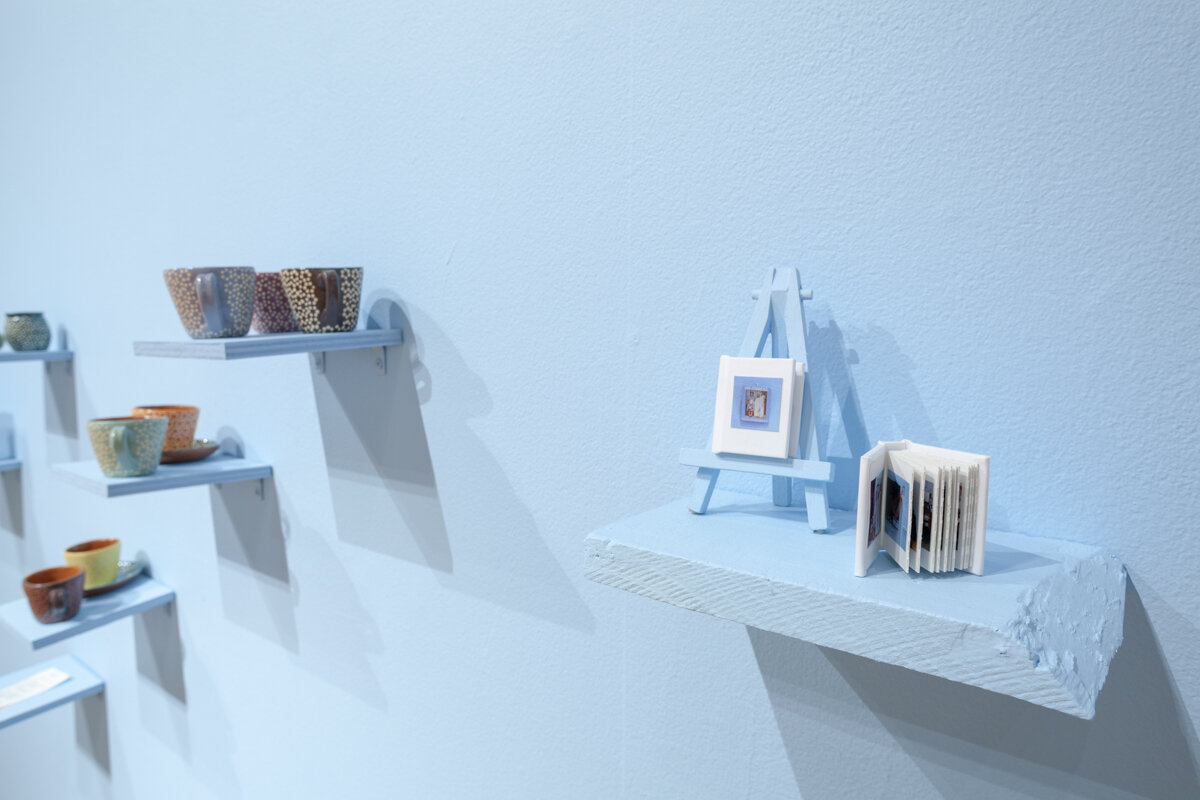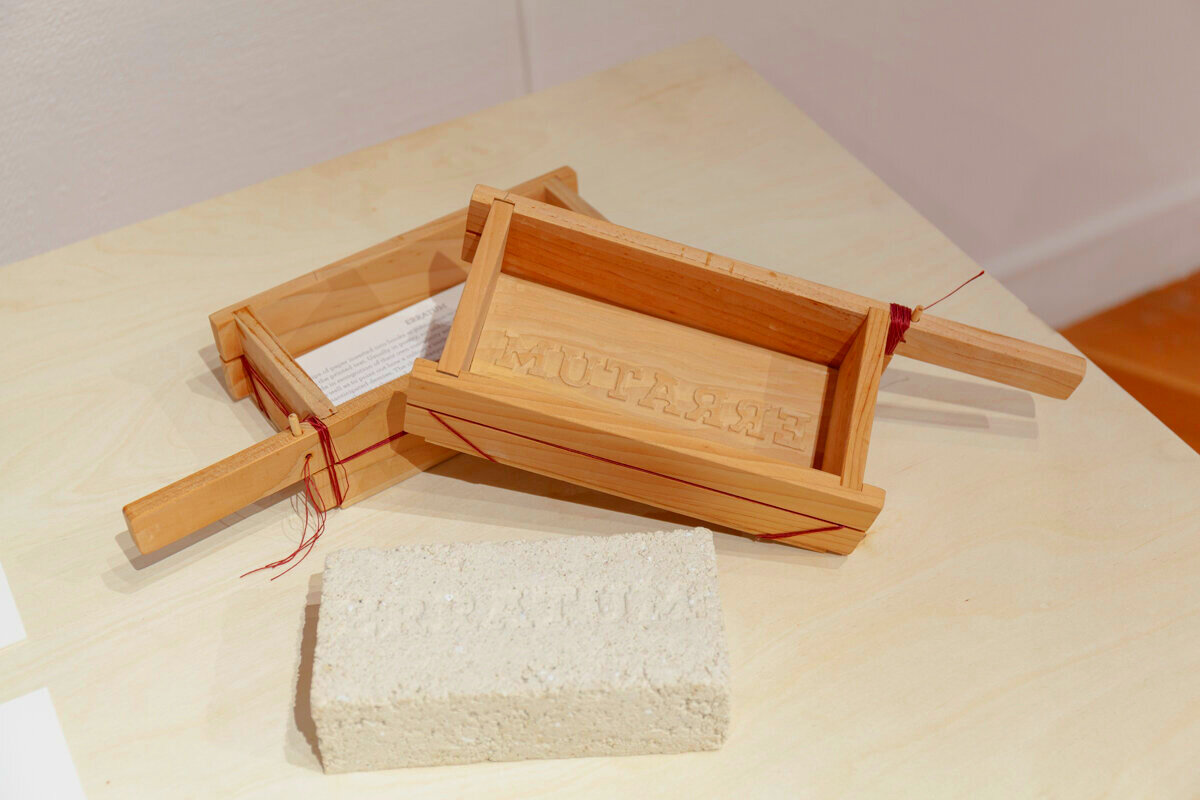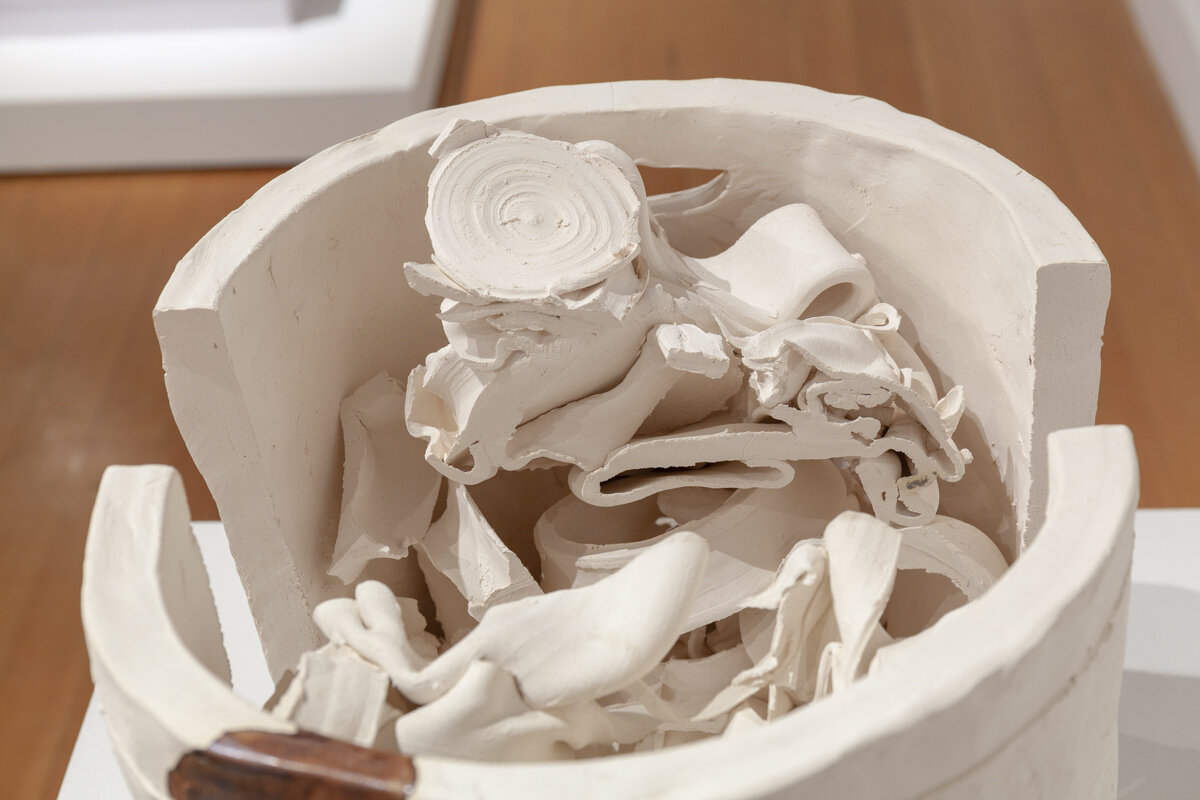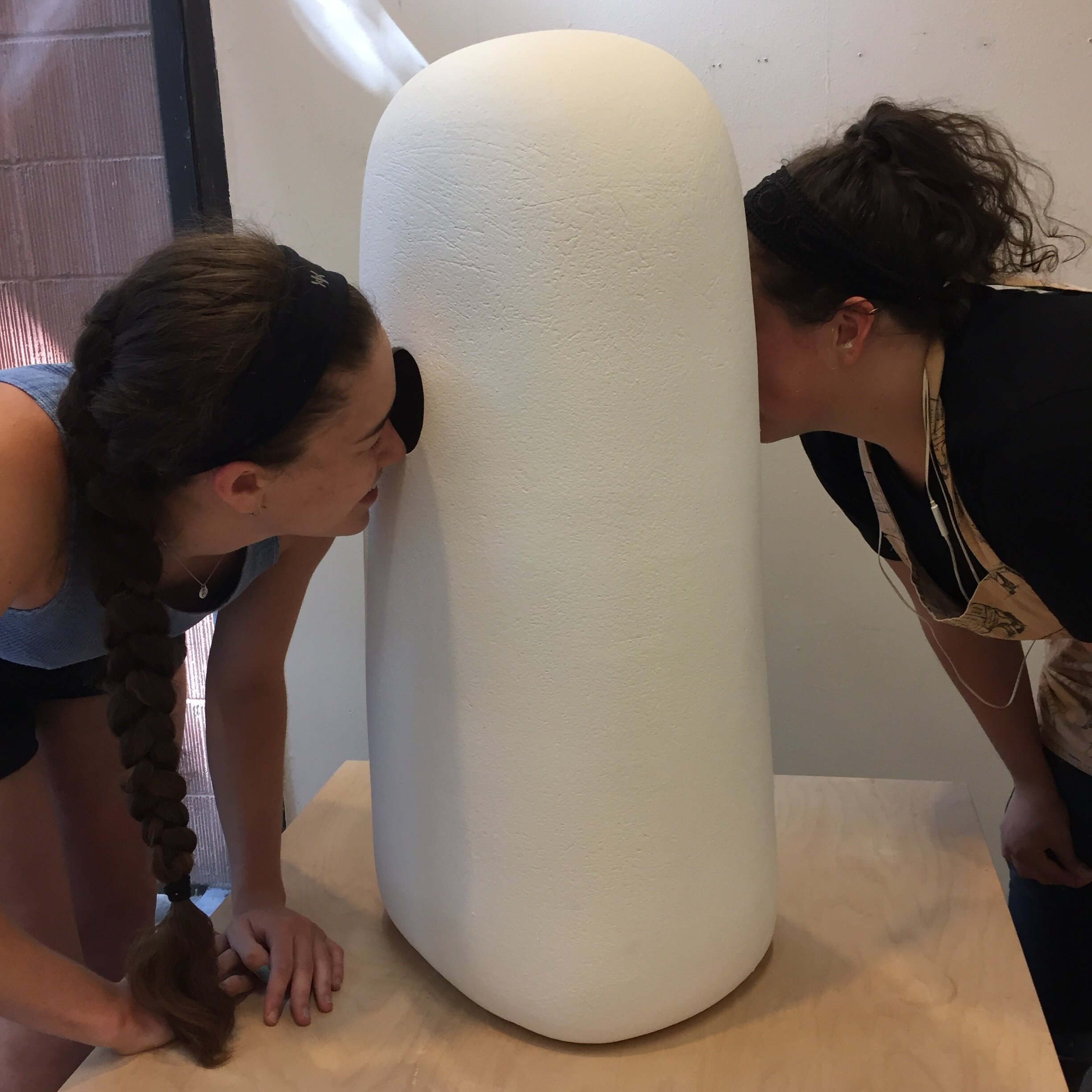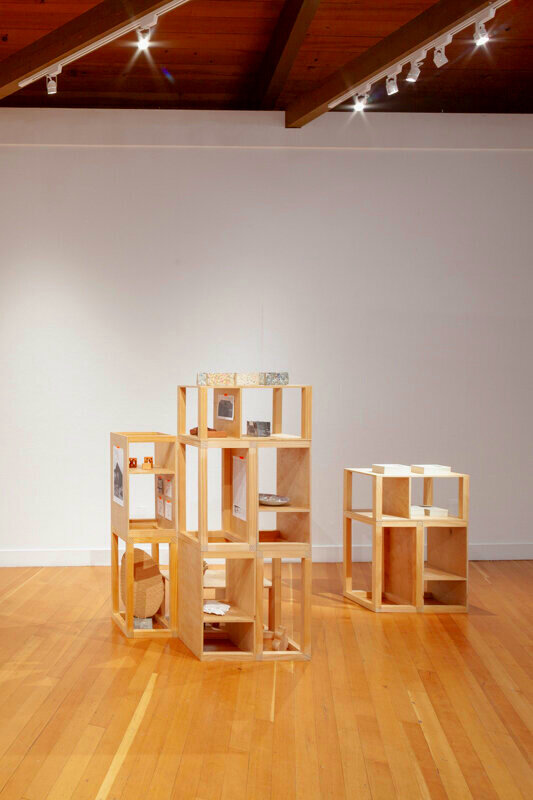Gallery Exhibition
Origin STORIES: Expanded Ceramics in the Bay Area
March 10 – May 8, 2021
Ebitenyefa Baralaye, Sita Kuratomi Bhaumik and María Inés Leal García, The Brick Factory, Ilana Crispi, Futurefarmers, Nicki Green, Dana Hemenway, Kari Marboe, Mutual Stores, Stephanie Syjuco
Spanning the past decade, Origin Stories: Expanded Ceramics in the Bay Area surveys key works by 10 artists and artist groups who consider ceramics in relation to site and place. The exhibition foregrounds the contributions of both interdisciplinary artists and artists who primarily work with clay to a larger and vibrant contemporary field. Several artists bring a conceptually driven approach to functional ceramics, embracing the potential to invite participation and community engagement.
Overview by Curator Tanya Zimbardo
Artist and Curator Bios
Bay Area Cup Swap 2021
Online Commission by Mutual Stores
Artists in Conversation: Nicki Green with guest Nicole Seisler
”The Best Art I Saw in 2021,” by Sarah Hotchkiss, KQED Arts
Ebitenyefa Baralaye
In the video ContAxts (Tenderloin), dual sets of objects unexpectedly perform different formations on sidewalk corners and crosswalks. While the artist is off camera in this performance, the coiled forms suggest the presence of abstracted footsteps. Ebitenyefa Baralaye has likened their movements to mapping his immediate surroundings of a neighborhood block. The Detroit-based artist made this work while living in the Tenderloin of San Francisco during a teaching fellowship at the San Francisco Art Institute. Born in Nigeria and raised in the Caribbean and United States, Baralaye has embedded the narrative of migration in several works, observing: “We are very much as human beings always looking for nodes, for objects, for milestones, literally, to reference where we have been, what we are doing, and who we are now.”
Ebitenyefa Baralaye, still from ContAxts (Tenderloin), 2017, single-channel HD video (with sound), running time 3:57. Courtesy of the artist and David Klein Gallery, Detroit.
Ebitenyefa Baralaye, still from ContAxts (Tenderloin), 2017, stoneware, glaze, environment, various dimensions. Courtesy of the artist and David Klein Gallery, Detroit.
Sita Kuratomi Bhaumik and MarÍa Inés Leal García
MamaSita’s Tiny Teahouse is an ongoing project inspired by a desire for connection. The Oakland-based artist Sita Kuratomi Bhaumik originally created an installation in which she would serve masala chai and snacks to visitors, the diminutive scale playfully encouraging shifts in perception. The participatory chai stall format, and later chai workshops, are rooted in the artist’s family’s story in California. Her Japanese-Colombian mother learned to make masala chai for her Bengali father-in-law.
As fellows at the Montalvo Arts Center’s Lucas Residency Program in Saratoga, California, a collaboration began with María Inés Leal García, who was in residence with Dignicraft. The Mexican art collective and activist media production company supports artisans making lead-free ceramics in Michoacán, México. Their collaboration introduces another story: the production and distribution of Leal García’s signature cups made by hand from local clay and on sale at BAC throughout the exhibition. For several years, the artists have worked together, with her family and with Dignicraft, to produce and transport them safely across the border. A tiny artist book illustrates these events.
Installation of MamaSita’s Tiny Tea House, 2013, at Montalvo Arts Center, Saratoga, California. Image courtesy of the artists. Photo credit: Victor Chávez.
Sita Kuratomi Bhaumik and María Inés Leal García, MamaSita’s Tiny Tea House, 2013–ongoing, dimensions variable
Sita Kuratomi Bhaumik, MamaSita’s little librito documenting the journey of dignicraft ceramics across a big frontera, 2016, artist book, 1.5 in. x 1.75 in.
The Brick Factory AND friends
Pots in Action (@potsinaction), a curated Instagram feed (2015–19, founded by Ayumi Horie of Maine), challenged the ceramic canon and covered a wide range of themes with over 70 global guest hosts. For #PIAconceptual, hosted by Erik Scollon of The Brick Factory, people were invited to contribute their ‘ceramics truisms’ – a “remix” and nod to artist Jenny Holzer’s renowned Truisms series. The Brick Factory updated their CERAMICS TRUISMS (after Holzer) with these crowd-sourced texts, which is now available in the gallery as a takeaway tabloid print and online as a downloadable PDF. Formed in 2011, The Brick Factory is a ceramics and performance collective of Nicole Burisch (Ottawa, Ontario), Thomas Myers (St. Paul, Minnesota), Erik Scollon (San Francisco) and Summer Zickefoose (Youngstown, Ohio).
Also on view, Erik Scollon has organized a 2021 version of the BAY AREA CUP SWAP, with three ways to take part: in the gallery, by mail, and at a socially distanced closing weekend event in Live Oak Park. Ceramic artists/makers/potters/sculptors of any kind and all levels are encouraged to participate. This event is for everyone, especially self-identified amateurs, hobbyists, “Sunday potters,” and those who work in community centers and neighborhood studios. Find out more.
Ilana Crispi
The San Francisco Bay Area is known as one of the most expensive real estate markets in the country. Its historic Gold Rush is often brought into analogy with the tech industry boom. Ilana Crispi has been mining the soil under her rent-controlled apartment in the Mission District in San Francisco, transforming it into a range of ceramics. She invites passersby to pan the dirt for “gold” in a sluice box. Crispi has, in her words, created “a kind of guerrilla land grab” from under the home to share and discuss with members of the neighborhood. “I’m practicing alchemy,” she says. Each bag of Mission Dirt is valued at $1,092, the median list price per square foot in that neighborhood at the start of the project in 2017. She has also used the dirt to create pots to grow native plants, such as Yerba Buena, to make tea to share with the public from handmade cups. Incorporating furniture made from repurposed scaffolding, the Mission Dirt Project has been presented on the sidewalk, at outdoor community markets, and in galleries.
Ilana Crispi, Mission Dirt Project (detail), 2017–ongoing, dimensions variable
Ilana Crispi, Mission Dirt Project (detail), 2017–ongoing, dimensions variable
Futurefarmers
Amy Franceschini and Michael Swaine of Futurefarmers are seen in Erratum, a video animation of six performance acts. They smash a porcelain toilet with sledgehammers, reconstituting the shards into brick forms. Publishers issue an ‘erratum’ for a production error in a text. Configured as “a vessel for new ideas and regeneration,” Erratum: Brief Interruptions in the Waste Stream is a “reverse-readymade” distributed as an artist book. It was first executed and exhibited during a residency at the San Francisco Center for the Book. Each of the joined pairs of wooden molds holds a handmade brick and letterpress-printed cards on themes of inefficient indoor plumbing, waste processing systems, and their ecological impacts. Both the icon of the urinal and the chess game in this work refer to the artist and chess player Marcel Duchamp (1887–1968) and his influential idea of readymade sculptures. Founded in 1995, the collective Futurefarmers has since included artists, researchers, designers, farmers, scientists, engineers, and architects.
Futurefarmers, still from Erratum, 2010, single-channel video (silent), running time 4:18. Image courtesy of the artists and Gallery 16.
Futurefarmers, Erratum: Brief Interruptions in the Waste Stream (detail), 2010, boxed artist book, edition of 40. Courtesy of San Francisco Center for the Book.
NICKI GREEN
When the University of California at Berkeley replaced the old kiln in the Ceramics Studio, graduate student Nicki Green found potential to critically reflect on this change. It was originally installed by the ceramics program’s legendary founder, the artist Peter Voulkos (1924–2002). She incorporated salvaged kiln bricks and floor tiles into a body of resulting sculptures. SOFT BRICK features a base containing kiln bricks supporting a vessel filled with cast-off, recycled stoneware from the artist’s studio. Through a performance lecture and artist publication of the same title, Green offers her perspective as a trans woman artist, witnessing the physical and symbolic dismantling of the space Voulkos built.
Nicki Green, SOFT BRICK, 2017, glaze on stoneware with painted MDF and brick from Peter Voulkos’ kiln at University of California, Berkeley, 55 in. x 36 in. x 36 in.
Nicki Green, SOFT BRICK (detail), 2017
DANA HEMENWAY
Porcelain nails occupy holes in the wall left from hanging hardware from previous exhibitions. Dana Hemenway’s subtle intervention into the gallery space upends values associated with art objects and display, with a precious material such as porcelain used to re-create a common utilitarian object. More recently, Hemenway has used functional items such as light bulbs and electrical cords to weave through ceramic forms or a gallery wall. Through an adjacent pair of new ceramic works with pink lights installed above the doorway, Hemenway draws attention to a distinct, but often overlooked, architectural detail of the threshold between the Berkeley Art Center’s gallery and lobby.
Dana Hemenway, Untitled (nails), 2010, porcelain, various dimensions. Image courtesy of the artist and Eleanor Harwood Gallery, San Francisco.
Dana Hemenway, Untitled (Light Weave #5 – Pink) and Untitled (Light Weave #6 – Pink), 2021, ceramic, glaze, X-mas lights, various dimensions. Commissioned by Berkeley Art Center. Courtesy the artist and Eleanor Harwood Gallery, San Francisco
KARI MARBOE
Kari Marboe’s Looking Sculpture greets visitors in BAC’s lobby, where floor-to-ceiling windows allow views to the outside through the object’s enigmatic hole. In Extra Good Showing, she surfaces correspondence between the ceramics manufacturer Gladding, McBean and their client, the pioneering woman architect Julia Morgan (1872–1957), over fulfilling a 1927 tile order. A Bay Area native, Morgan designed more than 700 buildings in California, three of which locally incorporated the company’s architectural terra cotta. Drawn from research at the California State Library, Marboe’s text is printed with clay the artist gathered onsite from Lincoln, California, where Gladding, McBean continues to operate today. In the related, humorous performance also titled Extra Good Showing, Marboe reads from this script and distributes clay from Lincoln to participants. With each direction given, they sculpt clay and “engage with a past form of correspondence, connect with a site-specific material, and perform an archive.”
Kari Marboe, one of the Looking Sculptures from the ongoing series since 2017, ceramic and wall paint. Image courtesy of the artist.
Kari Marboe, Looking Sculpture (detail showing the view through the hole of Stephen de Staebler’s Seated Woman with Horns on BAC’s sculpture patio)
Participants taking part in a performance of Extra Good Showing while the artist reads instructions from the script. Image courtesy of the artist.
MUTUAL STORES
In a pair of storefronts in Oakland, Mutual Stores provides artists with studio and gallery space, and hosts a residency program based around the experimental reuse of ceramic waste. The artist collective’s mission is to incorporate sustainable practices into every aspect of their studio operations and offer workshops to the local community. The Mutual Stores Archive features a collection of items from Mutual Artist in Residence Program: risograph-printed invitations to exhibitions and artist talks, publications, sculptural remnants, and a few material tests of waste (clay, glaze, sand). The archive is designed to be displayed in various iterations. In this exhibition, it includes bricks pressed from waste paper and clay made by co-founders Kate Pruitt and Rosa Novak with tania c.b., as well as handmade bricks from tania’s ongoing project brick library.
Tailings is a newly commissioned research project by Mutual Stores co-founders Rosa Novak and Kate Pruitt that traces the history of various ceramic materials sourced in California and contained within some of the artworks in this exhibition: calcium carbonate and fire clay. From industrial manufacturers to the hands of artists, they describe how these materials are “perpetually shifting form along their journey in and out of collective and individual waste streams.” A series of illustrated short writings, shared online here and through postcards in the gallery, explores “the vast life cycles of the mined materials that surround us.”
Mutual Stores, Mutual Stores Archive, 2018–2020, objects and printed material by Mutual Artists in Residence and studio members: Ken Becker, Michael Berens, Alyssa Block, tania c.b., Juan Huerta Coello, Torreya Cummings, Maya Goo, Brendan Page, Tracy Ren. Shelving design: Vivian Harp. Archive creation: tania c.b., Rosa Novak, Kate Pruitt. On the right: Tailings, 2020–21, research project, takeaway postcards, and online narrative.
Mutual Stores, Mutual Stores Archive (detail), 2018–2020. Image courtesy of the artists.
Mutual Stores, Mutual Stores Archive (detail), 2018–2020
STEPHANIE SYJUCO
In a digital animation, Stephanie Syjuco creates ‘mash-ups’ between indigenous objects from Belgium’s colonies and objects produced by Europe’s handicrafts industries. She scanned Congolese and Belgian Art Nouveau ceramic vessels from the collection of the Museum Aan de Stroom (MAS Museum) in Antwerp, and the City Museum Stellingwerff-Waerdenhof in Hasselt, Belgium, as part of a larger research-based project called Empire/Other supported by the FLACC Workplace for Visual Artists in Belgium. The resulting sequences present jagged, hybrid artifacts, with each pair of objects forced to collide and “become like the other.” The Oakland-based artist discovered that the algorithms were too complicated for the vessels to smoothly merge together. They exist as a digital rendering of an idea, defying being realized as newly-printed, three-dimensional ceramic objects. For Syjuco, the morphed and fractured results becomes a metaphor for the historical traumas of empire and colonization.
Stephanie Syjuco, still from Empire/Other, 2013, single-channel video (silent), running time 3:10. Image courtesy of the artist and Catherine Clark Gallery, San Francisco.

